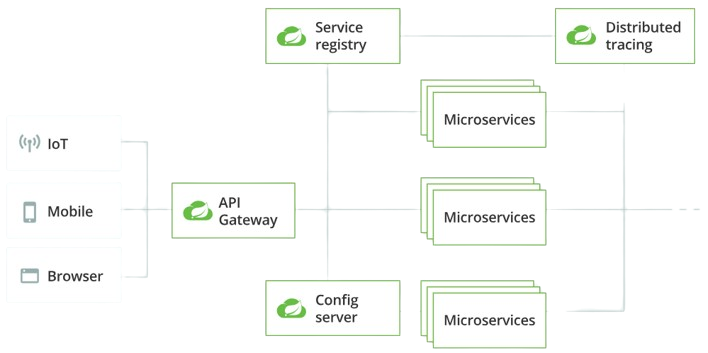The syllabus for Spring Cloud covers a comprehensive
range of topics essential for mastering microservices
architecture using the Spring Cloud framework.
Module 1: Introduction to Spring Cloud
- Overview of Cloud Computing
-
Microservices Architecture vs. Monolithic Architecture
- Introduction to Spring Cloud
-
Benefits of Using Spring Cloud for Microservices
- Setting Up the Development Environment
Module 2: Spring Boot Fundamentals
- Introduction to Spring Boot
- Building Microservices with Spring Boot
- Configuring Spring Boot Applications
- Spring Boot Auto-Configuration
- Creating RESTful Services with Spring Boot
Module 3: Service Discovery with Eureka
- What is Service Discovery?
- Introduction to Netflix Eureka
- Setting Up Eureka Server
- Registering Microservices with Eureka
-
Service Discovery and Client-Side Load Balancing
- Configuring Eureka Clients
Module 4: Client-Side Load Balancing with Ribbon
- Introduction to Netflix Ribbon
- Ribbon Configuration in Spring Cloud
-
Integrating Ribbon with Eureka for Load Balancing
- Customizing Ribbon Load Balancing Strategies
Module 5: API Gateway with Spring Cloud Gateway
- Introduction to API Gateways
- Benefits of Using API Gateways
- Setting Up Spring Cloud Gateway
- Configuring Routes and Predicates
- Implementing Filters and Customizations
-
Integrating Gateway with Eureka for Dynamic Routing
Module 6: Circuit Breaker with Resilience4j
- Understanding Circuit Breaker Patterns
- Introduction to Resilience4j
- Setting Up Resilience4j in Spring Cloud
- Configuring Circuit Breakers for Microservices
- Fallback Methods and Circuit Breaker States
- Monitoring and Managing Circuit Breakers
Module 7: Distributed Configuration with Spring Cloud
Config
- Introduction to Centralized Configuration
- Setting Up Spring Cloud Config Server
- Managing Configurations in Git
- Accessing Configurations from Config Server
-
Dynamic Configuration Updates with Spring Cloud Bus
Module 8: Distributed Tracing with Spring Cloud Sleuth
and Zipkin
-
Importance of Distributed Tracing in Microservices
- Introduction to Spring Cloud Sleuth
- Setting Up Sleuth for Tracing
- Introduction to Zipkin for Distributed Tracing
- Integrating Spring Cloud Sleuth with Zipkin
- Visualizing Traces in Zipkin Dashboard
Module 9: Messaging with Spring Cloud Stream
- Introduction to Event-Driven Microservices
- Overview of Spring Cloud Stream
- Creating Message Producers and Consumers
- Understanding Binders and Channels
-
Configuring Messaging Middleware (e.g., RabbitMQ,
Kafka)
-
Error Handling and Retries in Spring Cloud Stream
Module 10: Security in Spring Cloud
- Securing Microservices with Spring Security
- OAuth2 and OpenID Connect in Microservices
-
Implementing Security with Spring Cloud Security
- Integrating Spring Security with OAuth2 and JWT
-
Protecting Microservices with API Gateway Security
Module 11: Monitoring and Logging
- Introduction to Application Monitoring
- Using Spring Boot Actuator for Monitoring
-
Setting Up Metrics Collection and Dashboards (e.g.,
Prometheus, Grafana)
-
Centralized Logging with ELK Stack (Elasticsearch,
Logstash, Kibana)
- Log Aggregation with Spring Cloud Sleuth
Module 12: Deployment Strategies and Best Practices
- Packaging Microservices with Docker
- Container Orchestration with Kubernetes
-
Deploying Spring Cloud Applications to Cloud Platforms
(e.g., AWS, Azure, Google Cloud)
-
Best Practices for Developing and Deploying Spring
Cloud Applications
- Handling Failures and Scaling Microservices
Module 13: Advanced Topics (Optional)
- Reactive Microservices with Spring WebFlux
-
Using Spring Cloud Contract for Consumer-Driven
Contract Testing
- Implementing Service Mesh with Istio
- Blue-Green Deployment and Canary Releases
Conclusion and Final Project
-
Building a Complete Microservices Application with
Spring Cloud
- Integrating Different Spring Cloud Components
- Best Practices and Real-World Use Cases
- Review and Q&A
This syllabus provides a solid foundation in Spring
Cloud, enabling developers to build scalable, resilient,
and maintainable microservices-based applications.



